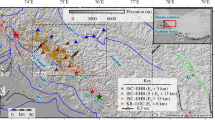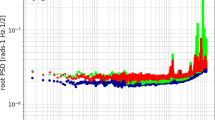Abstract
Reliable information on the horizontal orientation of a seismometer is crucial to seismological research utilizing three-component seismograms. In this study, we provide misorientation angles of broadband seismometers in three permanent networks in South Korea from 2003 to 2021 by using two methods, denoted as PPCA and PminT, both utilizing P-wave polarization characteristics. Our estimates show that 36% of the sensors have been aligned within 5° from the geographic north during their operation periods, while 40% of the sensors have been rotated by more than 10° at least once. The estimates are highly consistent for both methods, with 95% of the total showing uncertainty less than 10°. Moreover, we identified a significant number of temporal changes in misorientation by taking automatic change point detection and visual inspection. The procedure described here and misorientation angles can be useful reference for seismic data preprocessing for research utilizing horizontal-component seismograms for earthquake sciences.
Similar content being viewed by others
References
Aminikhanghahi, S. and Cook, D.J., 2017, A survey of methods for time series change point detection. Knowledge and Information Systems, 51, 339–367.
Beyreuther, M., Barsch, R., Krischer, L., Megies, T., Behr, Y., and Wassermann, J., 2010, ObsPy: a Python toolbox for seismology. Seismological Research Letters, 81, 530–533.
Braunmiller, J., Nabelek, J., and Ghods, A., 2020, Sensor orientation of Iranian broadband seismic stations from P-wave particle motion. Seismological Research Letters, 91, 1660–1671.
Büyükakpinar, P., Aktar, M., Maria Petersen, G., and Köseoglu, A., 2021, Orientations of broadband stations of the KOERI seismic network (Turkey) from two independent methods: P-and Rayleigh-wave polarization. Seismological Research Letters, 92, 1512–1521.
Doran, A.K. and Laske, G., 2017, Ocean-bottom seismometer instrument orientations via automated Rayleigh-wave arrival-angle measurements. Bulletin of the Seismological Society of America, 107, 691–708.
Eisermann, A.S., Ziv, A., and Wust-Bloch, G.H., 2015, Real-time back azimuth for earthquake early warning. Bulletin of the Seismological Society of America, 105, 2274–2285.
Ekström, G. and Busby, R.W., 2008, Measurements of seismometer orientation at USArray transportable array and backbone stations. Seismological Research Letters, 79, 554–561.
Ekström, G. and Nettles, M., 2018, Observations of seismometer calibration and orientation at USArray stations, 2006-2015. Bulletin of the Seismological Society of America, 108, 2008–2021.
Ensing, J.X. and van Wijk, K., 2018, Estimating the orientation of borehole seismometers from ambient seismic noise. Bulletin of the Seismological Society of America, 109, 424–432.
Harris, C.R., Millman, K.J., van der Walt, S.J., Gommers, R., Virtanen, P., Cournapeau, D., and Kern, R., 2020, Array programming with NumPy. Nature, 585, 357–362.
Herrmann, R.B., 2013, Computer programs in seismology: an evolving tool for instruction and research. Seismological Research Letters, 84, 1081–1088.
Jurkevics, A., 1988, Polarization analysis of three-component array data. Bulletin of the Seismological Society of America, 78, 1725–1743.
Kang, T.S. and Baag, C.E., 2004, The 29 May 2004, Mw = 5.1, offshore Uljin earthquake, Korea. Geosciences Journal, 8, 115–123.
Kennett, B.L.N. and Engdahl, E.R., 1991, Traveltimes for global earthquake location and phase identification. Geophysical Journal International, 105, 429–465.
Killick, R., Fearnhead, P., and Eckley, I.A., 2012, Optimal detection of changepoints with a linear computational cost. Journal of the American Statistical Association, 107, 1590–1598.
Kim, K.H., Ree, J.H., Kim, Y., Kim, S., Kang, S.Y., and Seo, W., 2018, Assessing whether the 2017 Mw 5.4 Pohang earthquake in South Korea was an induced event. Science, 360, 1007–1009.
Kim, S., Rhie, J., and Kim, G., 2011, Forward waveform modelling procedure for 1-D crustal velocity structure and its application to the southern Korean Peninsula. Geophysical Journal International, 185, 453–468.
Kim, W.Y., Choi, H., and Noh, M., 2010, The 20 January 2007 Odaesan, Korea, earthquake sequence: reactivation of a buried strikeslip fault?. Bulletin of the Seismological Society of America, 100, 1120–1137.
Kim, Y., He, X., Ni, S., Lim, H., and Park, S.C., 2017, Earthquake source mechanism and rupture directivity of the 12 September 2016 Mw 5.5 Gyeongju, South Korea, earthquake. Bulletin of the Seismological Society of America, 107, 2525–2531.
Kim, Y., Rhie, J., Kang, T.S., Kim, K.H., Kim, M., and Lee, S.J., 2016, The 12 September 2016 Gyeongju earthquakes: 1. Observation and remaining questions. Geosciences Journal, 20, 747–752.
Korea Meteorological Administration, 2019, Earthquake Annual Report. Korea Meteorological Administration, Seoul, 220 p. https://www.kma.go.kr/download_01/earthquake/earthquake_2019.pdf [Accessed on 19 September 2021].
Laske, G., Masters, G., and Zu, W., 1994, Frequency-dependent polarization measurements of long-period surface waves and their implications for global phase-velocity maps. Physics of the Earth and Planetary Interiors, 84, 111–137.
Lee, H. and Sheen, D.H., 2015, A study on determination of orientation of borehole seismometer. Journal of the Geological Society of Korea, 51, 93–103.
Lee, S.J. and Rhie, J., 2015, Determining the orientations of broadband stations in South Korea using ambient noise cross-correlation. Geophysics and Geophysical Exploration, 18, 85–90.
Lim, H., Deng, K., Kim, Y.H., Ree, J.H., Song, T.R., and Kim, K.H., 2020, The 2017 Mw 5.5 Pohang earthquake, South Korea, and poroelastic stress changes associated with fluid injection. Journal of Geophysical Research: Solid Earth, 125, e2019JB019134. https://doi.org/10.1029/2019JB019134
Lim, H. and Kim, Y.H., 2020, A dataset of seismic sensor responses of South Korea seismic stations. Journal of the Geological Society of Korea, 56, 515–524.
Lim, H., Kim, Y., Song, T.R.A., and Shen, X., 2018, Measurement of seismometer orientation using the tangential P-wave receiver function based on harmonic decomposition. Geophysical Journal International, 212, 1747–1765.
Liu, K.H. and Gao, S.S., 2013, Making reliable shear-wave splitting measurements. Bulletin of the Seismological Society of America, 103, 2680–2693.
Niu, F., Bravo, T., Pavlis, G., Vernon, F., Rendon, H., Bezada, M., and Levander, A., 2007, Receiver function study of the crustal structure of the southeastern Caribbean plate boundary and Venezuela. Journal of Geophysical Research: Solid Earth, 112, B11308.
Niu, F. and Li, J., 2011, Component azimuths of the CEArray stations estimated from P-wave particle motion. Earthquake Science, 24, 3–13.
Ojo, A.O., Zhao, L., and Wang, X., 2019, Estimations of sensor misorientation for broadband seismic stations in and around Africa. Seismological Research Letters, 90, 2188–2204.
Park, D., Cho, S.I., Lee, Y.H., Choi, W.H., Lee, D.H., and Kim, H.S., 2018, Site monitoring system of earthquake, fault and slope for nuclear power plant sites. Economic and Environmental Geology, 51, 185–201.
Pearson, K., 1901, Principal components analysis. The London, Edinburgh, and Dublin Philosophical Magazine and Journal of Science, 6, 559–572.
Rueda, J. and Mezcua, J., 2015, Orientation analysis of the Spanish Broadband National Network using Rayleigh-wave polarization. Seismological Research Letters, 86, 929–940.
Scholz, J.R., Barruol, G., Fontaine, F.R., Sigloch, K., Crawford, W., and Deen, M., 2017, Orienting ocean-bottom seismometers from Pwave and Rayleigh wave polarisations. Geophysical Journal International, 208, 1277–1289.
Scognamiglio, L., Tinti, E., and Michelini, A., 2009, Real-time determination of seismic moment tensor for the Italian region. Bulletin of the Seismological Society of America, 99, 2223–2242.
Shin, J.S., Sheen, D.H., and Shin, I.C., 2009, Orientation correction for borehole seismic stations in South Korea. Journal of the Geological Society of Korea, 45, 47–54.
Stachnik, J.C., Sheehan, A.F., Zietlow, D.W., Yang, Z., Collins, J., and Ferris, A., 2012, Determination of New Zealand ocean bottom seismometer orientation via Rayleigh-wave polarization. Seismological Research Letters, 83, 704–713.
Truong, C., Oudre, L., and Vayatis, N., 2018, Ruptures: change point detection in Python. arXiv Preprint, arXiv:1801.00826.
Wang, X., Chen, Q.F., Li, J., and Wei, S., 2016, Seismic sensor misorientation measurement using P-wave particle motion: an application to the NECsaids Array. Seismological Research Letters, 87, 901–911.
Woo, J.U., Rhie, J., Kim, S., Kang, T.S., Kim, K.H., and Kim, Y., 2019, The 2016 Gyeongju earthquake sequence revisited: aftershock interactions within a complex fault system. Geophysical Journal International, 217, 58–74.
Xu, H., Luo, Y., Tang, C.C., Zhao, K., Xie, J., and Yang, X., 2018, Systemic comparison of seismometer horizontal orientations based on teleseismic earthquakes and ambient-noise data. Bulletin of the Seismological Society of America, 108, 3576–3589.
Xu, W., Yuan, S., Wang, W., Luo, X., and Li, L., 2020, Comparing orientation analysis methods for a shallow-water ocean-bottom seismometer array in the Bohai Sea, China. Bulletin of the Seismological Society of America, 110, 3174–3184.
Zahradník, J. and Custódio, S., 2012, Moment tensor resolvability: application to southwest Iberia. Bulletin of the Seismological Society of America, 102, 1235–1254.
Zeng, S., Zheng, Y., Niu, F., and Ai, S., 2020, Measurements of seismometer orientation of the first phase CHINArray and their implications on vector-recording-based seismic studies. Bulletin of the Seismological Society of America, 111, 36–49.
Zha, Y., Webb, S.C., and Menke, W., 2013, Determining the orientations of ocean bottom seismometers using ambient noise correlation. Geophysical Research Letters, 40, 3585–3590.
Zheng, H., Fan, J., Zhao, D., Li, C., Dong, D., Zhang, G., and Wang, X., 2020, A new method to estimate ocean-bottom-seismometer orientation using teleseismic receiver functions. Geophysical Journal International, 221, 893–904.
Zhu, H., Tian, Y., Zhao, D., Li, H., and Liu, C., 2019, Seismic structure of the Changbai intraplate volcano in NE China from joint inversion of ambient noise and receiver functions. Journal of Geophysical Research: Solid Earth, 124, 4984–5002.
Zhu, G., Yang, H., Lin, J., and You, Q., 2020, Determining the orientation of ocean-bottom seismometers on the seafloor and correcting for polarity flipping via polarization analysis and waveform modeling. Seismological Research Letters, 91, 814–825.
Acknowledgments
This work was supported by SNU Student-directed Education Undergraduate Research Program through the Faculty of Liberal Education, Seoul National University (2020). The authors thank W.-Y. Kim, H. Lim, H. Kang, and J.Y. Park in Seoul National University for assistance on data curation and constructive suggestions which improved the quality of the work. The authors acknowledge support from the Nuclear Safety Research Program through the Korea Foundation of Nuclear Safety (KoFONS), granted financial resource from the Nuclear Safety and Security Commission (NSSC), Republic of Korea (No. 1705010). Y. Kim acknowledges support from Creative-Pioneering Researchers Program through Seoul National University (SNU SRnD 3345-20160014).
Author information
Authors and Affiliations
Corresponding author
Additional information
Publisher’s Note
Springer Nature remains neutral with regard to jurisdictional claims in published maps and institutional affiliations.
Electronic supplementary material
Rights and permissions
About this article
Cite this article
Son, Y.O., Seo, MS. & Kim, Y. Measurement of seismometer misorientation based on P-wave polarization: application to permanent seismic network in South Korea. Geosci J 26, 235–247 (2022). https://doi.org/10.1007/s12303-021-0031-5
Received:
Accepted:
Published:
Issue Date:
DOI: https://doi.org/10.1007/s12303-021-0031-5




